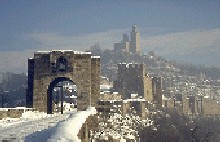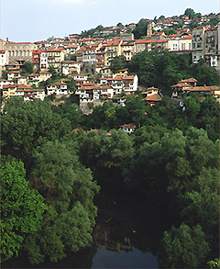|
|
| |
BULGARIA
VELIKO TURNOVO
Veliko Turnovo - one of the most picturesque Bulgarian towns, standing in tiers above Yantra River which meanders through the elevations of Turnovo and the three hills - Tsarevets, Trapezitsa and Sveta Gora, 241 km north-east of Sofia. Population of 67 000. A station along the railway line Rouse-Podkova.
Known under the name of Tsarevgrad Turnov (i.e. King's Town) and Turnovgrad. In the town and its outskirts traces have been uncovered of life dating back to the late Palaeolithic, Neolithic, Chalcolithic, the Bronze and the Iron Ages. It raises to significance during the years of Byzantine rule (9th-12th centuries).
 After the foundation of the Second Bulgarian Kingdom (1186), the town becomes its capital. A centre of medieval Bulgarian coin minting. In the 13th-14th centuries in the town and its outskirts numerous literary schools spring up - centres of educational and literary activity.
In 1393 the town is conquered by the Turks and burned down. During the years of Ottoman rule it is a fortress of the Bulgarian national spirit and one of the centres of the struggle for liberation. In 1879 the Constituent National Assembly has its first session here and adopts the Constitution of Turnovo - the first constitution of the Bulgarian state liberated in 1878.
Valuable architectural ensembles dating back to the Bulgarian National Revival have preserved the atmosphere of the past century. The buildings, perching one above the other, overhang rocks and precipices and Yantra River below, standing close to one another along narrow winding streets. The great master builder Kolyo Ficheto - a self-educated architect of the Bulgarian National Revival - worked here. The antique part of the town has been declared an architectural and historical reserve.
A university, a theatre, a historical museum, an art gallery.
St. Demerius of Thessaloniki Church - a medieval church in Asenova Mahala. Upon its consecration in 1185 the Uprising of Asen and Petur against Byzantine rule for the restoration of the Bulgarian state is declared here. In later years the coronation ceremonies of the next tsars of the Asens' dynasty are held. Its architecture is characteristic of the churches of the Second Bulgarian Kingdom belonging to the so-called picturesque style, with rich facade decorations. Destroyed a number of times (18th C., the earthquake of 1913). In 1985 conservation and extensive reconstruction are undertaken. From the original building there have been preserved the abse, the fresco fragments of the 12th and the 14th centuries. Restored.
 St. Peter and Paul Church - a medieval church in Asenova Mahala. According to some scholars it was built in the 13th C. during the rule of Tsar Kaloyan, according to others - in the 14th C. In 1393 when the town was conquered by the Ottoman Turks, the notables of Turnovo were slaughtered here. During the years of Ottoman yoke it is a cathedral church of the Greek bishop. The church belongs to the type of cruciform churches of the so-called picturesque style. The facades are decorated with arched niches, glazed cups and four-petaled flowers. Partially preserved mural paintings (14th-15th centuries). Restored.
The Church of the Forty Holy Martyrs - a medieval church built probably in the 12th C. during the rule of Tsar Kaloyan. In the 13th C. it is renewed by Tsar Ivan Asen II to commemorate his victory over the Epir despot Kir Theodoros Comnenos at Klokotnitsa. The church is a late basilica with rich ceramic-plastic decoration on the facades. Fragments from the original mural paintings, dating back to 1230, are exhibited in the Archaeological Museum in Sofia, the National Historical Museum, the Historical Museum in Veliko Turnovo and also in the church; undergoing a process of restoration. On one of the columns there is a dug-in inscription on the construction history of the church, known as the Turnovo Inscription of Tsar Ivan Asen II. Columns with inscriptions of Khan Omourtag (814-831) and Khan Kroum (803-814) have been inbuilt in the church. In later years the Great Lavra Monastery appears near the church. During the Ottoman rule these are turned into teke (Muslim monastery) and mosque. The church is consecrated anew after the Liberation. In 1908 the vassalage from Turkey is overthrown and the independence of Bulgaria is proclaimed in the church. A tomb, in all probability the tomb of Tsar Kaloyan, has been uncovered in the church necropolis.
Sts. Constantine and Helena Church - a Bulgarian National revival church built in 1873 by master Kolyo Ficheto. One should see the various in form arches, which cover the separate areas. Most picturesque is the eastern facade divided by various in form arches. Exquisite bell-tower.
Hadzhi Nikoli Han - one of the few Bulgarian National Revival inns preserved to the present day. Built in 1858 by Kolyo Ficheto. It comprises several buildings. Most original is the design of the three-storied building in the far end of the yard, which includes store-rooms and guest-rooms, situated beyond the open arcade galleries. A museum.
The Old Town Hall (Konaka) - built in 1874-1876 by Kolyo Ficheto for a Turkish public building, but the design and space layout bears the signs of the Bulgarian National Revival secular architecture. In 1879 the Constituent National Assembly of newly liberated Bulgaria, which adopts the Constitution of Turnovo, has its first session in this building. A museum.
Tsarevets - a historical hill of 12 hectares in the eastern part of Veliko Turnovo. In the 7th-14th centuries the capital residences of the tsar, the boyars and the patriarch are erected. Built over a Thracian settlement and Byzantine fortress, dating back to the 4th-6th centuries, Tsarevets turns into an unapproachable fortress and capital of the Second Bulgarian Kingdom. It is surrounded by two fortified walls enforced by battle towers and flying buttresses (2,40 - 3,60 m thick). The main entrance is to the west, one passes three consecutive gates each of which is defended by a battle-tower and the rock in front of the first is cut so that a draw-bridge could be put and then withdrawn. At the western wall of the fortress one can see the Gate of Asen with a two-winged door and a two-storied tower. It links Tsarevets and Trapezitsa and the quarter between the two hills. The third main gate is in the south-eastern wall and leads to the quarters of foreigners at the foothills. This gate is equipped with a falling door. The palace compound is situated on the central plateau part of the hill. It is a separate fortress surrounded by strong walls. Most impressive is the northern facade of the palace with the main entrance. The throne-hall is in the western part. The patriarch's compound occupies the highest elevation. It is surrounded by fortified walls, enforced with towers and loop-holes. When the Turks conquered Turnovo, Tsarevets was burned down.
Trapezitsa - a hill in Veliko Turnovo. In the 12th-14th centuries Trapezitsa and Tsarevets comprise the Inner Town of the Bulgarian capital. The hill is plateau-like with steep slopes. Fortified with a fortress wall, which follows the rock wreath. Down the hill towards the river there are two additional fortified walls. The fortress has four main gates. The foundations of 17 churches have been preserved. On some of their inner walls one can see fragments of paintings. The style of the mural paintings is characteristic of the artistic school of Turnovo. It is supposed that the churches are family chapels. In the end of the 14th C. and the beginning of the 15th C. the Ottoman invaders burn down Trapezitsa.
The Transfiguration of Our Lord Monastery - situated in the Derventski Gorge of Yantra River, 7 km north of Veliko Turnovo. Founded under Tsar Ivan Aleksandur in the 14th C. Demolished after the capture of Turnovo by the Turks (1393), the monastery is reconstructed in the 30-ies of the 20th C. St. Andrey Purvozvani Chapel and the monastery the Transfiguration of Our Lord Monastery are built in 1834. In the later years Kolyo Ficheto erects the Church of the Annunciation, the bell-tower and finishes the Transfiguration of Our Lord Church.
Mural paintings, iconostasis and icons by Zahariy Zograf, Papa Vitan Mladi, Stanislav Dospevski and others. The monastery is one of the revolutionary centres during the years of the struggle for national liberation.
|
|
|
Festivals and Fairs
The Great Koprivshtitza Folklore Festival
The Great Koprivshtitza Folklore Festival is Bulgaria's largest gathering of traditional musicians and singers and is a cross between a pop festival and a medieval fair. It is a sight that knows no equal: thousands of musicians and singers making the hillside above the picturesque village of Koprivshtitza their home for a few days. Coupled with this you have the colourful stalls of the traders and the thousands of visitors who come for the festival.
This is Bulgarian music as it was always played, played by the ancestors of those who first played it. But perhaps it is what happens on the periphery that is the most authentic. Strolling players or soloists, simply playing for the sheer enjoyment. forming new bonds with other musicians or just letting their music ring out over the hillside.
The Bourgas International Folk Festival
The Bourgas International Folk Festival, held annually, attracts a host of Bulgarian and international artists and is held in the second half of August.
The Kazanluk Festival
The Kazanluk Festival of the Roses is held annually in early June, and has grown from a local to an international event. Not only are the roses, Kazanluk's main industry, in full flower. but the town itself blossoms while visitors enjoy the "Rose Picnic" and all the fun of a folklore festival, with its costumes, songs and dance. Should you still have the energy left, you can always visit the old factories where the rose oil is extracted.
St. Trifon's Day
In the agricultural calendar, St. Trifon's Day celebrates the pruning of the vines, and is held on February 14.
Kukerov Den
On the first Sunday before Lent, Kukerov Den celebrates the start of the agricultural year, and all over Bulgaria you can witness processions led by the dancing. leaping Kukeri dressed in colourful masks and costumes.
Baba Marta
Baba Marta is celebrated on March 1 when peasant house-holds brush out the winter cobwebs with a traditional spring clean. and people offer each other tokens of good luck called martenitsas.
Kukeri
Like western countries. the Bulgarian calendar is dotted with important feast days and festivals. The festival of the Kukeri re-enacts ancient surovaki rites to ward off evil spirits and Kukeri fertility rites. Although only held once every five years, it brings together dancers from all over Bulgaria in a rainbow of colours and styles.
St. Lazarus Day
Lazaruvane is also celebrated in spring on St. Lazarus Day, and here village girls considered fit for marriage perform ritual songs and dances.
St. Konstantin and St. Elena Day
The coming of summer is traditionally celebrated on St. Konstantin and St. Elena Day on May 21, and in some of the remoter villages in the Stranzha hills fire dancing, dancing on heated coals, is still practised in celebration of summer's arrival. Ethnologists have suggested that this practice is directly descended from Dionysina rites of the ancient Thracian.
|